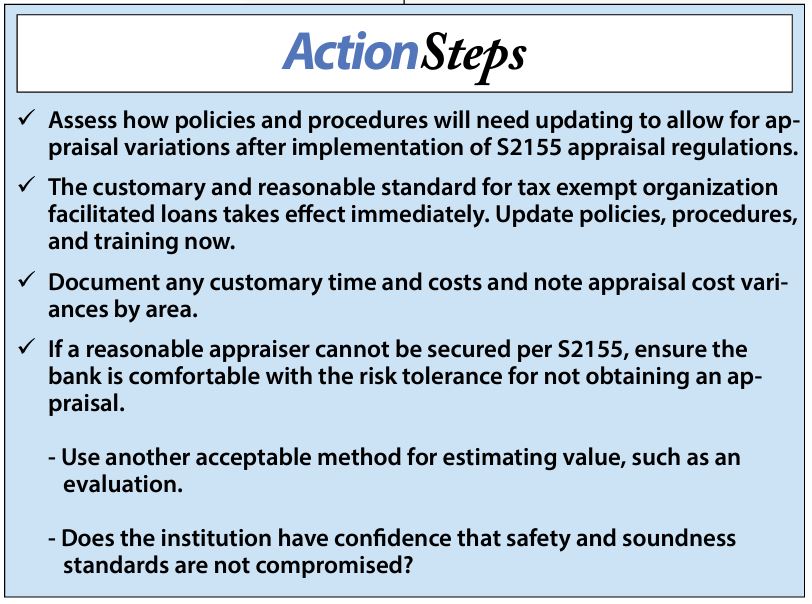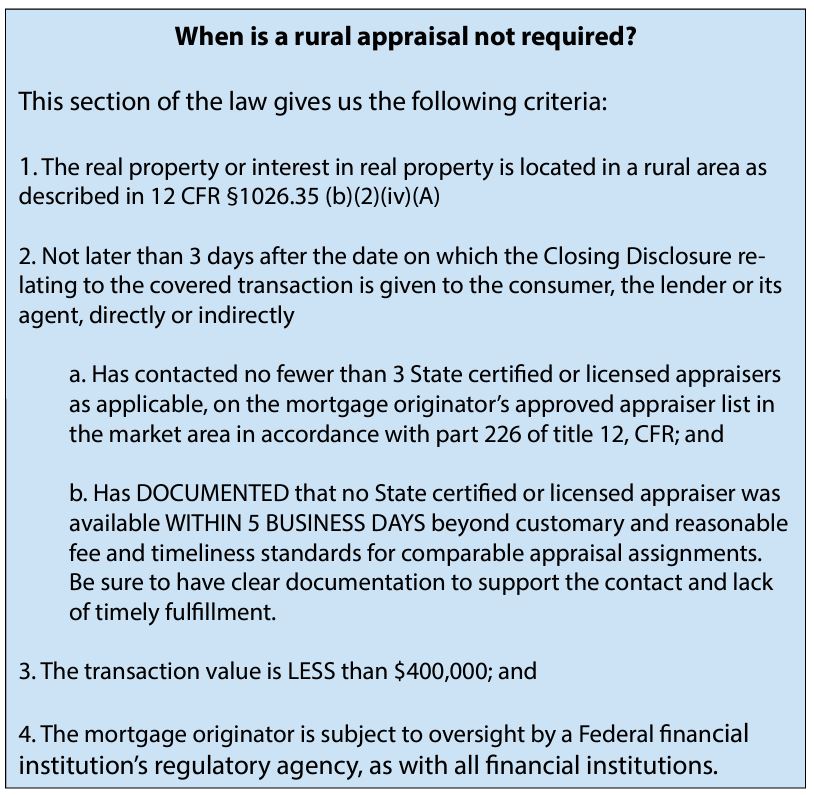As published in ComplianceAction by Mollie Sudhoff, August 2018
The Economic Growth, Regulatory Relief, and Consumer Protection Act (“EGRRCPA”) has been hailed by many as “relief” from certain onerous terms of the Dodd Frank Act (“Dodd Frank”). The law is frequently referred to as “S2155” by the industry, indicating the bill number assigned to the law passed by the Senate. Regardless of the benefits, there are many new compliance changes to be implemented over the next few months. Here we will focus only on what compliance officers need to understand about the new law’s appraisal requirements.
We all welcome a bit less focus on the onerous provisions of Dodd Frank, but with reform comes change. With change comes remodeling of programs, products and systems and yet another re-training. A key question still to be answered is whether this new law diminishes or enhances consumer protection. The EGRRCPA addresses real estate appraisals and the valuation of donated appraisal services and exemptions to obtaining an appraisal on properties in rural areas. Another question is whether S2155 will diminish the importance of compliance departments. The early assessment is that the compliance focus will be different, but regulatory compliance will be as important as ever. Some say it will be even more important as we navigate even more changes!
Appraisals and Sound Economic Policy
 Accurate and dependable appraisals and valuations of property is a foundation for sound economic decision making for both buyers and financers of residential property. Back in 1989, Congress prescribed appropriate standards for the performance of real estate appraisals in connection with “federally related transactions.” Dodd Frank further detailed the necessity for appraisals, sought to define how to mandate that appraisals must only performed by an independent, qualified party, and also that the appraiser receives reasonable and customary compensation for the activities and professional services performed. When a loan is secured by residential real property, specific appraisal requirements must be followed. Loose lending standards by some in the years leading up to the housing crisis of the mid 2000’s renewed the necessity of accurate and independent appraisals. Regulation Z’s appraisal independence section addresses some of these specific requirements. Just how far are you willing to go to take advantage of the exception appraisal.
Accurate and dependable appraisals and valuations of property is a foundation for sound economic decision making for both buyers and financers of residential property. Back in 1989, Congress prescribed appropriate standards for the performance of real estate appraisals in connection with “federally related transactions.” Dodd Frank further detailed the necessity for appraisals, sought to define how to mandate that appraisals must only performed by an independent, qualified party, and also that the appraiser receives reasonable and customary compensation for the activities and professional services performed. When a loan is secured by residential real property, specific appraisal requirements must be followed. Loose lending standards by some in the years leading up to the housing crisis of the mid 2000’s renewed the necessity of accurate and independent appraisals. Regulation Z’s appraisal independence section addresses some of these specific requirements. Just how far are you willing to go to take advantage of the exception appraisal.
Donated Appraisals
Section 102. Safeguarding Access to Habitat for Humanity Homes. This section specifically states that “if a fee appraiser voluntarily donates appraisal services to an organization eligible to receive tax-deductible charitable contributions, such voluntary donation shall be considered customary and reasonable for the purposes of paragraph (1).” In plain language, lenders don’t have to worry about violating §1026.42 (f) of Regulation Z “valuation independence” which requires appraisers be compensated in a fair manner in limited circumstances. Since many institutions have relationships with local Habitat for Humanity affiliates or other non-profits to fund the housing transactions, this section may be applicable in circumstances where appraisers volunteer their services for the benefit of these programs. Before S2155, the regulations did not provide guidance for accepting donated appraisals. Bank employees often donate services to charitable organizations, especially President Jimmy Carter’s famous Habitat for Humanity. Donating appraisal services seems consistent with civic responsibility and serves as a positive opportunity for the appraisers to do something generous for Habitat or other charitable organizations. Appraisers are not generally employees of the financial institution in most cases and charge for their services. We applaud the appraisers who are willing to donate such services, but lenders are required to make sure appraisers continue to be paid fairly in all but the covered tax-exempt situations.
Taking advantage of this “relief” will require that policies and procedures be updated to recognize when a donated appraisal is acceptable in the event you or your organization plans to donate services. A process must be in place to verify that the entity for whom the appraisal is being purchased is tax-exempt under IRS rules, for example a Section 501(c)(3) tax-exempt status. The bank will need to verify all the above and document the same for the loan file.
Training of loan officers and loan processors must include clear guidance as to when donated appraisals are acceptable. For example, if a bank is providing loans to low income individuals under a special program and has appraisers willing to donate services but the applicants themselves are not coming to the lender via a tax-exempt organization like Habitat, then such donated appraisals will not pass muster under S2155 and will not be considered customary and reasonable. This section is effective immediately, so be sure to take advantage of the appraisal donations where applicable.
Appraisals in Rural Areas
Section 103. Exemption from Appraisals of Real Property Located in Rural Areas. While guidance is necessary, and regulations are anticipated, the second and likely more common exemption from appraisal requirements relates to real estate located in “rural” areas. Study this carefully to avoid overreaching S2155’s relief parameters. The language of this section may at first seem like a boon to banks in small towns and those serving rural clients. However, the details behind this potential exemption are far from a blanket exemption from all rural property appraisals.
Lenders need to do a lot of searching and documenting, starting with the bank’s policies and procedures for what is a “customary and reasonable” fee for appraisals in the area. Banks will need to verify that the policy covers these appraisal details. If the policy does not already state how many appraisers will be contacted, this also may need to be updated. One area requiring clarification in the regulations is how to determine whether a property is located in a designated rural area to use this exemption. While Regulation Z’s Section 35 already outlines a method to determine rural status, the implementing regulations could provide more clarity to the steps for use in this appraisal exemption evaluation. It could require use of the United States Department of Agriculture’s web site to find the Urban Influence Codes (“UIC”) or use of a service that meets the specified criteria. The USDA provides a listing of all counties in the United States and the respective UIC that gives clarity to whether a county is in a metropolitan area, a micropolitan area, adjacent to such, etc.
The UIC alone does not specifically call out a county as rural or not. We need to analyze the description provided in the codes to satisfy the definition of “rural” in Regulation Z. Regulation §1026.35 (b)(2)(iv)(A) states that an area is “rural” during a calendar year if it is:
- A county that is neither in a metropolitan statistical area nor in a micropolitan statistical area that is adjacent to a metropolitan statistical area.
- A census block that is not in an urban area as defined by the U.S. Census Bureau using its latest information; or
- A county or a census block designated as rural by the BCFP pursuant to the application process established under section 89002 of the Helping Expand Lending Practices in Rural Communities Act, (the FAST Act).
Carefully verify the address of the property, the transaction amount (loan amount, NOT the appraised property value, is less than $400,000), and whether under the Reg Z definitions the county qualifies as rural.
Here is an example of a county with a very small population, that according to our reading of the amendment does not meet Reg Z’s rural definition. Kalawao County is located on the Hawaiian Island of Moloka’i. with a UIC of “2,” “small in a metropolitan area with one million or more in population.” In this example, the second smallest county in the country, Kalawao County, Hawaii, population 90 would not be considered rural for appraisal relief purposes!
Hawaii is a very diverse state of several islands and varying levels of population density and many rural and urban settings. However, even the tiny island of Moloka’i would not qualify as rural under Regulation Z since all but the small portion of steep land incorporated as Kalawao County is included in Maui County. Since Kalawao is located in this small metro area with one million or more in population, its individual county population of 90 does not afford it the rural status.
There are many other eccentric locations throughout the country, so we can only hope the regulation will make it easier to determine rural status.
What About FNMA & FHLMC?
The limitations of this exemption include prohibiting the institution from selling, assigning, or otherwise transferring the loan with a few exceptions. Included in the exceptions are instances where the loan is sold to another covered institution to retain in the respective institution’s portfolio, the bank or institution experiences bankruptcy or failure or where the bank is being merged with another institution. Additionally, the bank may sell or transfer the loan to a wholly owned subsidiary as long as the loan is still considered to be an asset of the originator for regulatory accounting purposes.
If the bank plans to sell in the secondary market, the investor or GSE’s requirements will need to be followed. This effectively means this appraisal exemption will not apply unless the GSE’s and other investors change their criteria.
Appraisal Exemption Exceptions
Regardless of availability and reasonably priced appraisers, certain transactions will not be afforded any leeway in obtaining the appraisal. If the appraisal is required by the bank’s regulator to meet safety and soundness requirements, or the loan is a Section 32 High-Cost Mortgage loan, no appraisal exception will be available.
What Next?
While we welcome the intended relief from delaying otherwise sound transactions when an appraiser is not available in rural areas, and the ability to consider donated appraisals as “reasonable and customary” these options are limited in application. Financial institutions must ensure that policies, procedures, and training are updated as soon as regs are released. Remember, banks must always first consider their credit and compliance risk tolerance. You may always still opt to obtain an appraisal to be conservative.


